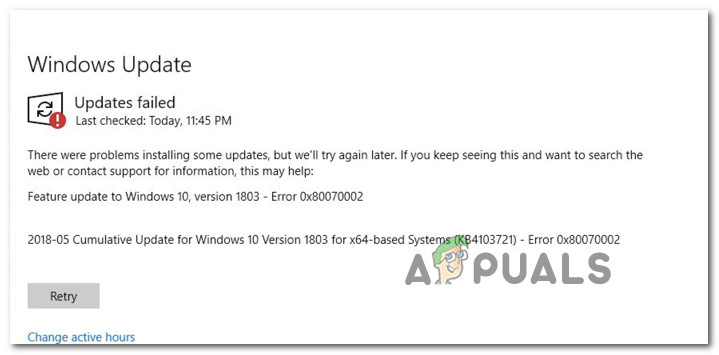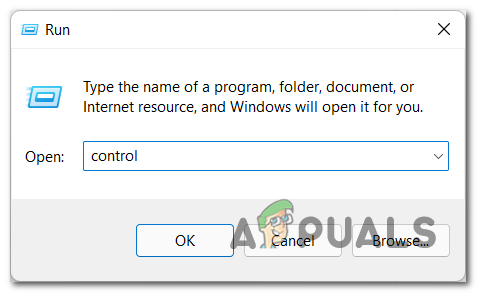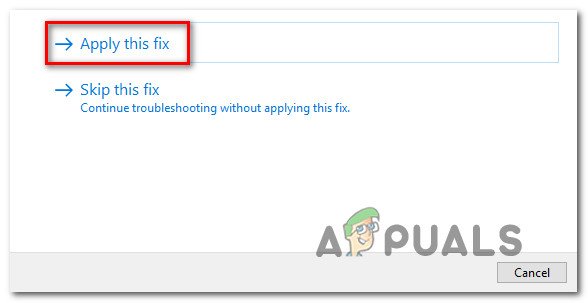If you’re experiencing the Windows Update 0x80070002 error while trying to install a certain Windows Update (or every pending update), you are not the only one. This error is very common on both Windows 10 and Windows 11 and it can be caused by several different underlying causes.

After investigating this particular issue thoroughly, we realized that there are actually several different underlying scenarios that will end up causing this Windows Update error (0x80070002).
To help you pinpoint and fix the culprit that’s causing the 0x80070002 error, we’ve listed all the potential causes that are most likely responsible for this issue:
- Common Windows Update Inconsistency – The first thing you should do when troubleshooting this issue is to see if your Windows installation is not capable of taking care of the issue automatically. If the problem is already covered by one of the automated repair strategies included with your OS, running the Windows Update troubleshooter might end up resolving the issue automatically.
- Incorrect date and/or time – Keep in mind that whenever a new Windows Update needs to be installed, your system will perform a series of checks to ensure that the connection is not malicious. If your system dates and time does not match the expected server equivalent, the connection will be interrupted. If this scenario is applicable, you should ensure that the date and time are up to date.
- Inconsistent Windows Update service – Another potential scenario that you should explore is a situation where the main Windows Update service is not correctly configured. To resolve this problem, you’ll need to access the Services screen and make the necessary adjustments.
- Corrupted temporary Windows Update files – As it turns out, this problem can also occur due to some type of inconsistency affecting the main Windows Update cache folder or all the complementary folders used in the process of updating (CatRoot2 & SoftareDistribution). To fix this issue, you can go ahead and reset every relevant sub-component of Windows Update and clear the two temp folders responsible for hosting temporary Windows Update files.
- The issue is caused by the AllowOSUpgrade key – According to a lot of users that we’re experiencing this issue while attempting to install the final update that upgrades Windows to the latest iteration, the culprit might be a registry key called AllowOSUpgrade. To address this issue, you’ll need to open up Registry Editor and modify the default configuration of this key.
- Conflicting 3rd party antivirus or firewall – As it turns out, certain overprotective antivirus or firewall tools are also known for causing this type of issue. If you suspect that your security suite is causing this problem, you can try to temporarily disable the real-time protection or temporarily uninstall the security suite (if it includes a firewall component).
- System File Corruption – Under certain circumstances, there are scenarios that will see this problem occurring due to some kind of corruption affecting your Windows files. To address this issue, you should try to deploy a DISM and SFC scan, restore your PC to a healthy state using System Restore or perform a repair install / clean install.
Now that you’ve become familiar with every scenario that will cause this problem, let’s go over every verified fix that will cause the 0x80070002 error to occur.
Run the Windows Update Troubleshooter
If you’re experiencing issues with Windows Update and multiple pending WU updates are failing to install with the same 0x80070002 error, our first suggestion is to try running the Windows Update troubleshooter.
Note: This utility is designed to automatically identify and fix common problems.
The troubleshooter on Windows 11 is much more comprehensive than earlier versions. Microsoft has added dozens of new automated repair strategies that can be applied with a single click if a recognizable scenario is identified.
If you haven’t tried this fix yet, follow the instructions below to run the Windows Update Troubleshooter and apply the recommended fix automatically:
Important: The instructions below will work on every recent interaction of Windows, not just Windows 11. You can use it on Windows 7, Windows 8.1, and Windows 10 too.
- To fix Windows Update, first, open a Run dialog box by pressing the Windows key + R.
- Next, type ‘control’ inside the text box and press Enter to open up the classic Control Panel interface.

Accessing the control menu Note: If you’re prompted by the User Account Control, click Yes to grant admin access.
- Once you’re inside the Control Panel window, use the search function (top-right corner of the screen) to search for ‘troubleshoot’. From the list of results, click on Troubleshooting.

Accessing the troubleshooting tab - Inside the Troubleshooting tab, go under System and Security and click on Fix problems with Windows Updates.
- After you get to the first Windows Update troubleshooter prompt, click Next and wait for the initial scan to complete.
- If a viable fix is found, click on Apply this fix to apply it on this particular PC.

Apply the recommended fix Note: Keep in mind that with some types of fixes that get recommended, you might be required to perform a series of manual steps.
- After the fix is successfully applied, restart your PC and attempt to install the failing update once again.
If this method didn’t help you fix the issue, move down to the next potential fix below.
Set the Correct Time and Date
When trying to install a pending update, your PC will attempt to connect to a WSUS server. Before the download is validated, the server will cross-check the date, time, and timezone values against the values expected. That’s why it is important to make sure that your computer’s time and date are set correctly. If they are not, you may encounter the 0x80070002 error.
This is because WSUS is very particular about requirements, and one of the most important requirements is having the correct date, time, and time zone.
Fortunately, several users have found that they can fix this problem by simply adjusting the time, date, and time zone settings via the Date & Time utility.
Follow the instructions below to make sure that the date and time are correctly established:
- Open up the Run dialog box by pressing the Windows key + R.
- Next, type ‘timedate.cpl’ in the text box and press Enter to open the Date and Time window.

Accessing the Date & Time menu - When you’re inside the Date & Time window, access the Date and Time tab, then click on Change date and time.

Accessing the Date & Time menu - Prompted by the UAC (User Account Control), click Yes to grant admin access.
- In the Date and time settings, set the correct values for Time and Date using the calendar and digital clock before clicking Ok to save changes.

Accessing the Date and Time menu Note: Optionally, if your timezone is off, return to the Date and Time tab and click on Change Time Zone to modify the timezone to UTC value.
- Click Apply to save changes, then restart your computer and see if the issue is fixed once the next startup is complete.
- Attempt to install the same Windows update that was previously failing and see if the problem is now fixed.
If the same kind of issue is still occurring, move down to the next potential fix below.
Clear the temporary Windows Update files
If you got this far without a viable fix, you’re likely dealing with a bug that is affecting the Windows Update troubleshooter.
Since the methods above have not been effective, the next best thing you can do is deploy the same repair strategies in order to reset every Windows Update component that might be causing issues with your pending Windows updates.
The most common instance that will cause this kind of issue is one or more WU (Windows Update) components that are currently stuck in a limbo state (they’re neither open nor closed). If this scenario is applicable, you will be able to fix the problem by resetting all WU components that are involved in the updating process.
Here’s what you need to do:
- To start, open a Run dialog box by pressing Windows key + R.
- Next, type “cmd” in the text box and press Ctrl + Shift + Enter to open an elevated Command Prompt.

Open up an elevated Command Prompt Note: When you see the UAC (User Account Control) prompt, click Yes to grant administrative privileges.
- Once you’re in the elevated Command Prompt, type the following commands in order and press Enter after each one to stop all WU related services:
net stop wuauserv net stop cryptSvc net stop bits net stop msiserver
Note: Just so you know what you’re telling the terminal to do, these commands will stop the Windows Update Services, MSI Installer, Cryptographic services, and BITS services.
- After every relevant service has been stopped, use the following commands to clear and rename SoftwareDistribution and Catroot2 folders:
ren C:\Windows\SoftwareDistribution SoftwareDistribution.old ren C:\Windows\System32\catroot2 Catroot2.old
Note: These folders store updated files used by the WU component. Renaming these folders will force your OS to create new healthy equivalents that will not be affected by corruption.
- Now that the folders have been cleared, run the following commands to re-enable the services we disabled earlier:
net start wuauserv net start cryptSvc net start bits net start msiserver
Restart your PC once again and see if the problem is now fixed.
If the same 0x80070002 error is still occurring, move down to the next method below.
Edit the AllowOSUpgrade key via Registry Editor
We’re receiving reports from users that they’re encountering an issue when trying to install the latest Windows update. It seems that the cause of the problem may be a registry key called AllowOSUpgrade. To fix the issue, you’ll need to open Registry Editor and change the default settings for this key.
This method can help you solve the “Something happened 0x80070002” error when installing a Windows upgrade.
Here’s what you need to do:
- To begin, press the Windows logo key + R on your keyboard at the same time.
- Type in ‘regedit’ inside the text bot, then press Enter to access the Registry Editor.

Open up the Registry Editor Note: You may need administrative rights to open it; if so, click Yes to confirm.
- Once you’re inside the Registry Editor, navigate to the following location:
HKEY_LOCAL_MACHINE\SOFTWARE\Microsoft\Windows\CurrentVersion\WindowsUpdate\OSUpgrade
Note: You can either navigate here manually or you can paste the path above directly into the navigation bar above and press Enter to get there instantly.
- Once you’re inside the correct location, select the OSUpgrade key, then right-click on the empty area on the right side of Registry Editor.
- After that, click New, then DWORD (32-bit) Value.
- Right-click the newly created ‘NewValue#1’ and select Modify.
- Change the value name to AllowOSUpgrade, and double-click the number under Value data. Enter 1, select Hexadecimal, and click OK.
- Finally, restart your computer and try again to see if it works.
If the Windows updates are still failing to install, move down to the next method below.
Disable the 3rd party antivirus (if applicable)
If you’re having trouble installing the final update that will upgrade you to Windows 11, it could be because of a 3rd party security interference.
Important: Some antivirus suites are known to conflict with the Windows 11 Upgrade assistant – Zone Alarm and the free version of AVG is the most commonly reported.
In most cases, you can disable the 3rd party antivirus temporarily by right-clicking on the AV’s taskbar icon and disabling the real-time AV shields. Just keep in mind that this will only work if the AV suite doesn’t have a firewall component.

If the suite does have a firewall component, follow the instructions below to uninstall the 3rd party tool and remove any remnant files before attempting to upgrade to Windows 11 again:
- To begin, press the Windows key + R to open a Run dialog box.
- Then, type ‘appwiz.cpl’ in the text box and press Enter to access the Programs and Features screen.

Open up the Programs and Features menu - Once you’re in the Programs and Features menu, scroll through the list of installed applications to find the 3rd party antivirus that may be conflicting with the installation of the pending update.
- When you locate the correct listing, right-click on it and choose Uninstall from the context menu.

Uninstall the antivirus that might be interfering with the Windows Update - In the uninstallation screen, follow the on-screen instructions to complete the uninstallation of the conflicting antivirus suite.
- After uninstalling the AV suite, follow this guide to make sure that no remnant Antivirus or firewall files were left behind.
- Once you have confirmed that the AV suite is uninstalled and there are no remnant files left, attempt to do the upgrade procedure again and see if the installation completes without the same 0x80070002 error.
If this method was not applicable in your particular scenario, move down to the next method below.
Deploy DISM and SFC Scans
The error code 0x80070002 is a very common error that can occur when there’s an inconsistency facilitated by some kind of corruption affecting Windows Update or an associated dependency.
In most cases, this error is caused by a corrupted system file that is preventing the auto-updating function from working properly.
If this sounds like it could be the problem you’re experiencing, the first thing you should do is run a couple of scans using the built-in System File Checker (SFC) and Deployment Image Servicing and Management (DISM) tools.
Both SFC and DISM have their similarities, but we recommend running both scans one after the other for the best chance of fixing any corrupted system files.
If this scenario applies to you, start with a basic SFC scan.

Note: Keep in mind that this tool is entirely local and will not require you to be actively connected to the internet.
Once you start the SFC scan, it’s crucial that you do not close the CMD window, even if the scan appears to be frozen. Wait patiently until the process is complete, as interrupting it may cause logical errors on your hard drive or SSD.
Once the SFC scan has finished successfully, reboot your computer and check to see if the issue has been fixed once the next startup is complete.
If you’re still seeing the 0x80070002 error when trying to run the Windows Update Troubleshooter, try running a DISM scan next and follow the on-screen prompts to finish up.

Note: One key difference between SFC and DISM is that DISM uses a sub-component of Windows Update to download healthy equivalents of any corrupted system files it finds. Because of this, you need to make sure that you have reliable internet before beginning this operation.
Once the DISM scan has finished successfully, restart your computer again and see if that has fixed the 0x80070002 error. If not, move on to the next potential fix below.
Use a System Restore
If you’ve tried all of the above methods to fix the 0x80070002 error and you’re still unable to install certain pending Windows Updates, the next thing you can try is to revert your machine to a previous system restore point. This has helped some users fix the issue.
Note: System Restore is a feature in Microsoft Windows that allows you to revert your computer’s state back to a previous point in time. This can be used to recover from system malfunctions or other problems.
Follow the instructions below to revert your PC back to a healthy state:
- Press the Windows key + R to open up a Run command.
- In the Run box, type “rstrui” and hit Enter to open the System Restore wizard.

Open up the System Restore screen - At the next screen, select Choose a different restore point and hit the Next button.

choose a different restore point - Select a restore point that is dated before you started experiencing high resource usage and hit the Next button again.
- Then, hit the Finish button to start the restoring process and wait for your PC to restart.
- At the next startup, attempt installing the same update that was previously failing with the 0x80070002 error and see if the problem is now fixed.
If the same kind of issue is still occurring, move down to the next potential fix below.
Perform a Repair Install or Clean Install
If you’ve tried all of the above steps and still can’t seem to fix the Windows Update 0x80070002 error, it’s probably because of a deeper system corruption that can’t be fixed using DISM or SFC scans.
Some users who had the same issue found that refreshing every Windows component worked for them. You can do this by doing a clean install or an in-place repair.
A clean install is simpler, but keep in mind that you’ll lose all your personal files (like applications, games, personal media, etc.) unless you back them up first.
If you choose to do an in-place repair instead, it’s a little more complicated, but you get to keep all your personal files including applications, games, personal media, and even some user preferences.
The post [Fix] Windows Update Error Code 0x80070002 appeared first on Appuals.com.


0 Commentaires